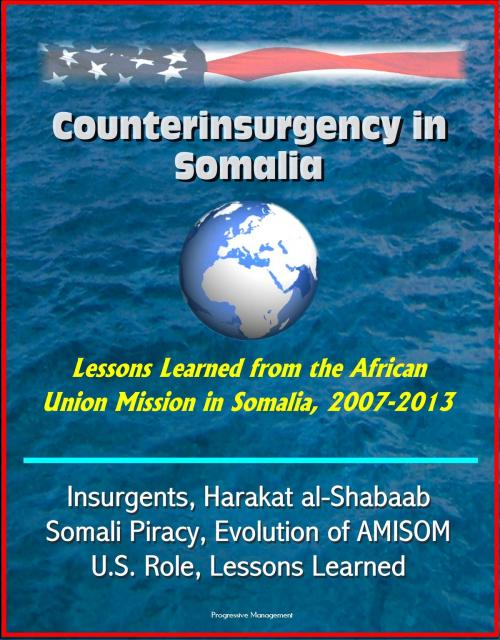Counterinsurgency in Somalia: Lessons Learned from the African Union Mission in Somalia, 2007-2013 - Insurgents, Harakat al-Shabaab, Somali Piracy, Evolution of AMISOM, U.S. Role, Lessons Learned
Nonfiction, History, Africa, Military| Author: | Progressive Management | ISBN: | 9781310217340 |
| Publisher: | Progressive Management | Publication: | January 27, 2016 |
| Imprint: | Smashwords Edition | Language: | English |
| Author: | Progressive Management |
| ISBN: | 9781310217340 |
| Publisher: | Progressive Management |
| Publication: | January 27, 2016 |
| Imprint: | Smashwords Edition |
| Language: | English |
Professionally converted for accurate flowing-text e-book format reproduction, this monograph provides a detailed case study of how the African Union's (AU) largest ever peace support operation—the African Union Mission in Somalia (AMISOM)—sought to achieve its objectives. Though AMISOM activities continue, this monograph covers the period from its initial deployment in March 2007 through December 2013. It is based on an analysis of AMISOM's genesis and evolution and its principal partners—the various forms of federal authorities in Somalia—and its principal opponent—Harakat al-Shabaab (the youth). Also included is an analysis of U.S. engagement with Somalia during this period.
The study does not offer a comprehensive assessment of the multiple forms of broader international engagement with Somalia but instead focuses on the AMISOM experience. Nor does the study seek to advance one simple argument about AMISOM or impose a single theoretical framework for analyzing the mission. Pushing one argument or framework makes little sense because AMISOM and the international context in which it operated evolved in significant ways between 2007 and 2013. Instead, the study is based on a historical and political analysis of the key players and seeks to draw out key strategic and political lessons from AMISOM's experiences.
Over the last two decades, Somalia's many violent conflicts have posed a series of security challenges and political headaches for numerous actors within the Horn of Africa and beyond, including the United States. This study focuses on the security challenges in Somalia presented by the rise of the Harakat al-Shabaab movement since 2005. This movement was started by a small group of militants, some of whom had ties to al-Qaeda. Within a few years it gained control over more than 40,000 square kilometers of territory and some five million people, and attracted recruits from many parts of the Somali diaspora and beyond. At times, it was also able to pose an existential threat to the federal authorities in Mogadishu and managed to inflict severe losses on its regional military opponents. Although it has now been dislodged from the major urban centers and is experiencing internal splits, al-Shabaab has not been completely defeated and it is possible that it could be resuscitated as a resistance movement.
Deployed to Mogadishu in early 2007, AMISOM was tasked with protecting key figures in Somalia's transitional governing institutions, mainly from their principal opponent: al-Shabaab. To that end, between 2007 and mid-2012, AMISOM grew from an initial deployment of some 1,500 Ugandan soldiers confined to a few bases in Mogadishu into a multidimensional force of nearly 18,000. This force included soldiers, police, and civilians from a variety of African states whose theater of operations spanned all of south and central Somalia. By December 2013 the mission's authorized strength had once again been increased to just over 22,000 uniformed personnel.
Professionally converted for accurate flowing-text e-book format reproduction, this monograph provides a detailed case study of how the African Union's (AU) largest ever peace support operation—the African Union Mission in Somalia (AMISOM)—sought to achieve its objectives. Though AMISOM activities continue, this monograph covers the period from its initial deployment in March 2007 through December 2013. It is based on an analysis of AMISOM's genesis and evolution and its principal partners—the various forms of federal authorities in Somalia—and its principal opponent—Harakat al-Shabaab (the youth). Also included is an analysis of U.S. engagement with Somalia during this period.
The study does not offer a comprehensive assessment of the multiple forms of broader international engagement with Somalia but instead focuses on the AMISOM experience. Nor does the study seek to advance one simple argument about AMISOM or impose a single theoretical framework for analyzing the mission. Pushing one argument or framework makes little sense because AMISOM and the international context in which it operated evolved in significant ways between 2007 and 2013. Instead, the study is based on a historical and political analysis of the key players and seeks to draw out key strategic and political lessons from AMISOM's experiences.
Over the last two decades, Somalia's many violent conflicts have posed a series of security challenges and political headaches for numerous actors within the Horn of Africa and beyond, including the United States. This study focuses on the security challenges in Somalia presented by the rise of the Harakat al-Shabaab movement since 2005. This movement was started by a small group of militants, some of whom had ties to al-Qaeda. Within a few years it gained control over more than 40,000 square kilometers of territory and some five million people, and attracted recruits from many parts of the Somali diaspora and beyond. At times, it was also able to pose an existential threat to the federal authorities in Mogadishu and managed to inflict severe losses on its regional military opponents. Although it has now been dislodged from the major urban centers and is experiencing internal splits, al-Shabaab has not been completely defeated and it is possible that it could be resuscitated as a resistance movement.
Deployed to Mogadishu in early 2007, AMISOM was tasked with protecting key figures in Somalia's transitional governing institutions, mainly from their principal opponent: al-Shabaab. To that end, between 2007 and mid-2012, AMISOM grew from an initial deployment of some 1,500 Ugandan soldiers confined to a few bases in Mogadishu into a multidimensional force of nearly 18,000. This force included soldiers, police, and civilians from a variety of African states whose theater of operations spanned all of south and central Somalia. By December 2013 the mission's authorized strength had once again been increased to just over 22,000 uniformed personnel.















